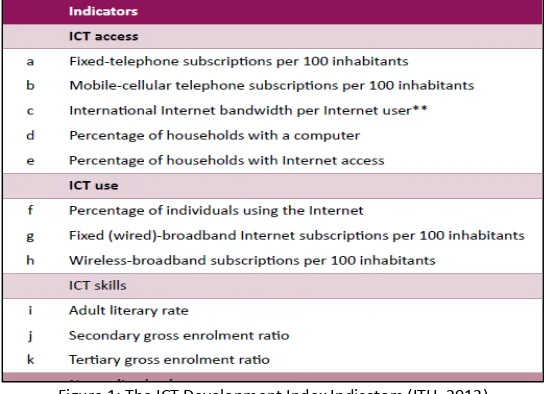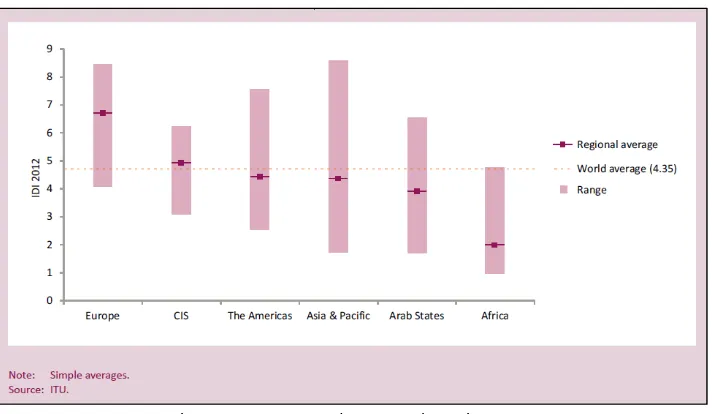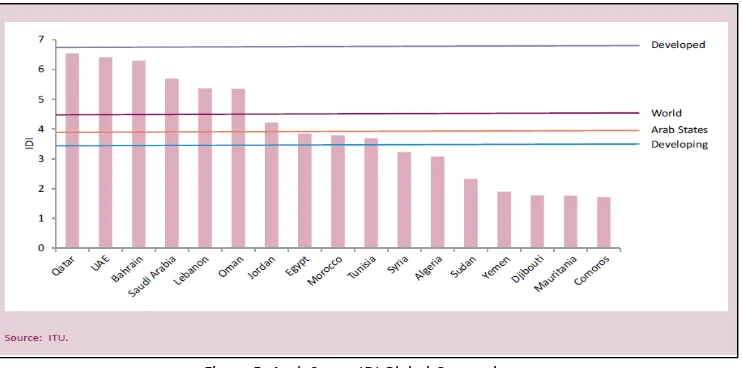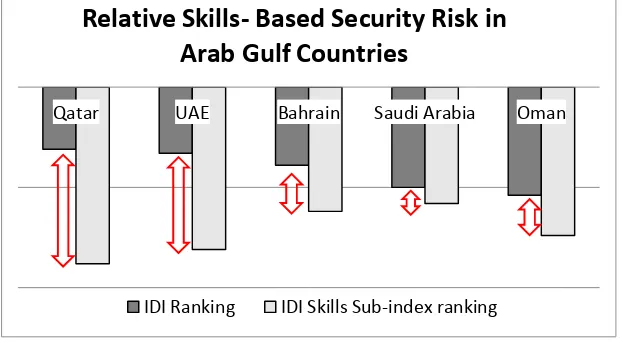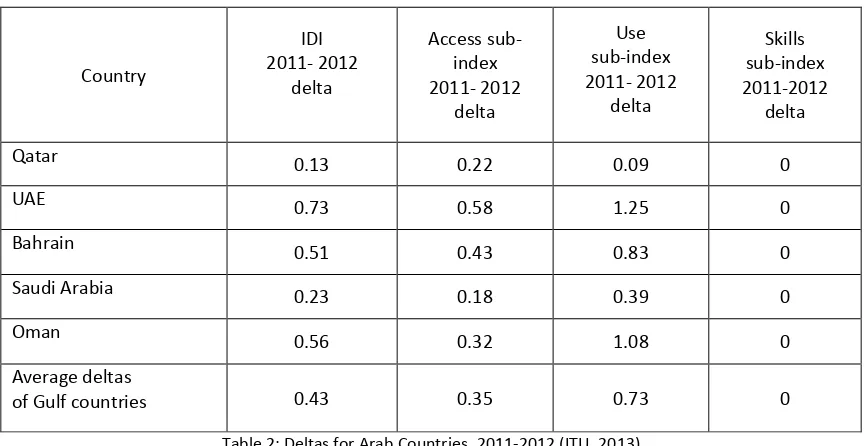Information Security and Digital Divide in the Arab World
Fathiya Al Izki and George R S Weir
Department of Computer & Information Sciences
University of Strathclyde
Glasgow G1 1XH
{fathiya.al-izki, george.weir}@strath.ac.uk
Abstract: The so-called ‘Digital Divide’ is a discrepancy in access to Information and Communication
Technology (ICT). In recent years, the meaning of this expression has become more nuanced and is no longer dependent on inability to have the new ICT which has become increasingly available, but depends more on the control of resources that guarantee the security of information. As with other developing countries around the world, the Digital Divide exists both within and between countries in the Arab world. Factors that determine the Divide are connectivity, knowledge, education, and economic capacity. Furthermore, there is a mutual impact between such a Digital Divide and information security in Arab countries. The International Telecommunication Union (ITU) in its 2013 report, gave a comprehensive global analysis of the Digital Divide. The present paper uses this ITU report as a basis to explore the Digital Divide in the Arab world and seeks to fill the absence of recent sub-skills data through review of relevant literature, toward a clearer appreciation of the mutual influence of Information Security and Digital Divide.
1
Introduction
Digital Divide can be defined as a ‘technological’ gap between individuals, families, social groups, countries and geographic areas based on their opportunities to access ICT and use the Internet for a wide range of activities. The existence of such a divide should not be considered an implication of the technological revolution, but rather, as one of the persistent socio-economic gaps in contemporary economies. As such, the Digital Divide mirrors existing social inequalities that simple become more apparent with the expansion of ICT.
In turn, the role of ICT in international development has generated considerable interest in the phenomenon of Digital Divide. This interest has generated many techniques to measure the Digital Divide at global, regional and local levels. Information Security, which has received great attention in recent years, has affected, and been affected by the multifaceted Digital Divide in many ways.
2
Information Security Challenges
An information society is a society where the creation, distribution, uses, integration and manipulation of information is a significant economic, political, and cultural activity. Such a society aims to gain competitive advantage internationally, through the use of information technology (IT) in a creative and productive way (Beniger, 1986). An information society is also a social development characterized by the ability of its members to obtain and share information instantly, anywhere, in the way that they prefer.
The UNESCAP report of 2008, states that information economy, among other elements, heavily depends on information security. Without the latter, the former cannot sustain its development. On the other hand, information security depends on technology development which, in turn, can pose new challenges for security. Information Security seeks to defend information from unauthorized access, use, disclosure, disruption, modification, or destruction. Information in this sense must be understood very broadly, covering not only the data and information, but also programs, knowledge, data flows, communications, and so on. This notion of information goes further to cover the computer system itself, which must be secured as well.
With the rapid growth in the number of computing devices and the corresponding increase of Internet use and online activities, many practices in everyday life tend to be computerized because of the considerable ease it represents. However, activities such as online payments, money transfers, and online communication, can be subjected to different types of threats likely to impair the integrity, confidentiality or availability of information, resulting from acts of malice, forgery and computer fraud, illegal trade practices, sexual abuse of children, offenses related to content and offenses related to intellectual property.
the information, especially potentially sensitive information, when data and programs are hosted on someone else's system. To be a victim or perpetrator, only a device such as computer, tablet or Smartphone, and an Internet connection are required. Also, the use of sophisticated analytical tools allows companies to better understand user behaviour and better target their offers, e.g., through use of cookies which track ones journey on the Internet. These techniques, are used for marketing purposes, and can also be used for modifying the provided information.
Thus, it can be said that, having an information society results in online activities that require specific tools and techniques to be monitored by information security specialists. One is an intrinsic part of the other because all the digital activities of the information society require not only privilege, but also skill. Many, if not all should be contextualized within a security-sensitive framework that turns the use of ICT into a safe practice.
3
The Multifaceted Digital Divide
A Digital Divide is an economic inequality between groups, broadly construed, in terms of access to, use of or knowledge of information and communication technologies (ICT). The Divide within countries can refer to inequalities between individuals, households, businesses, and geographic areas at different socioeconomic and other demographic levels, while the Divide between countries is referred to as the global Digital Divide, which designates nations as the units of analysis and examines the gap between developing and developed countries on an international scale (Chinn & Robert, 2004).
Ollivier (2006) argues that the Digital Divide is a multiple and complex concept at the same time, because it
reflects innumerable inequalities between men and women, rural areas and urban areas, ‘haves’ and ‘have
-nots’, taking into account the technological level, the rate of being connected, the number of machines, ICT budgets and more. Also it reflects differences in economic development (Gross domestic product per capita, costs of computer equipment), technology (bandwidth), energy (electricity), industry (low development software production) and language. So it can be said that technological development and the improvement of connectivity alone cannot suffice to bridge the Digital Divide.
Some researchers speak of a ‘dual Digital Divide’, or a 2nd degree Digital Divide, which refers to the required skills for users to access ICT. That is, the Digital Divide is related to issues of access to the benefits of digitization and the capabilities of a population or social group to use ICT appropriately and contribute to sustainable development. Ben Youssef (2004) distinguishes four dimensions to the Digital Divide: Digital Divide related to ICT equipment; Digital Divide due to the use of ICT; Digital Divide in terms of performance that is induced by the use of ICT; and Digital Divide as a ‘dynamic’ process related to ICT learning. Other scholars (e.g., Norris, 2001)
deal with the issue of Digital Divide in terms of 3 levels: 1 Global
2 Social 3 Democratic
Global Divide refers to differences between states, areas or regions. These are the differences in penetration of ICT in individual countries at a global level. A significant difference is observed in the penetration of ICT between developing countries and the rest of the world. Social Divide refers to differences in access to ICT, and accordingly to the information within each state, nation or region. It also includes differences between the information-rich and information-poor which are mostly due to social differences in society. For example, differences in access to ICT between residents of large cities and rural areas, between young and old, between men and women. Democratic Divide refers to differences between individuals who have access to ICT, but differ in the ability to exploit technologies. In particular, differences in the use of Internet in the daily activities and in how individuals with access to ICT are involved in public affairs (Norris, 2001). Additionally, the literature defines
what is called ‘Digital Literacy Divide’ as another facet to the Digital Divide. This is not related to technology access (infrastructure and equipment), but rather to the limited ability or competence of some people to operate computers, the Internet and technology in general (Korupp & Szydlik, 2005).
4
Digital Divide in the Arab World
In his empirical study to evaluate ICT diffusion in the Arab world, Touati (2008) stated that the region suffers
from a ‘double Digital Divide’. The first Divide is between rich Gulf countries, which have high access to ICT, and
the rest of the Arab world, where access to ICT technologies remains a challenge. The second Divide is between Arab countries and the rest of the world, and is related to lack of funding in research and development, lack of coordination between states and the often prohibitive costs of ICT.
issues and policies. These reasons have an effect on access to information and unequal ability to leverage the economic and social levels of intensive information activities.
Another comprehensive analysis and evaluation of ICT diffusion in the Arab world was conducted by the International Telecommunications Union (ITU). As a leader in ICT statistics worldwide, ITU has developed an ICT Development Index (IDI) with 11 indicators (Figure 1) and used this as a benchmark measure that serves to monitor and compare developments in ICT across countries.
Figure 1: The ICT Development Index Indicators (ITU, 2013)
The ICT Development Index (IDI) is divided into the following three sub-indices (Figure 1):
•
Access sub-index: captures ICT readiness, and includes five infrastructure and access
indicators (fixed telephone subscriptions, mobile cellular telephone subscriptions,
international Internet bandwidth per Internet user, percentage of households with a
computer and percentage of households with Internet access).
•
Use sub-index: captures ICT intensity, and includes three ICT intensity and usage indicators
(individuals using the Internet, fixed (wired) broadband subscriptions and wireless-broadband
subscriptions).
[image:3.595.161.434.153.350.2]•
Skills sub-index: captures ICT capability or skills as indispensable input indicators; includes
three proxy indicators (adult literacy, gross secondary enrolment and gross tertiary
enrolment).
According to the ITU 2013 report, Qatar tops the regional ranking (Figure 2), with an IDI of 6.54, followed by the UAE and Bahrain. Together with Saudi Arabia, Lebanon and Oman, these countries boast a higher IDI than the global average of 4.35 (Figure 3).
Figure 3: IDI ranges and averages, by region, 2012
The countries ranked at the bottom of the 2012 regional IDI, namely Yemen, Djibouti, Mauritania and Comoros, with IDI values of less than two, lie far below the developing-country average. A number of countries from the Arab States region with relatively high IDI values – Bahrain, Lebanon, Oman and the UAE – are among the most dynamic countries in the IDI 2012 (Figure 4). Most Arab countries with lower IDI values were unable to improve their IDI level to any significant extent, and are falling behind in international comparison.
Figure 4: Most dynamic countries (from IDI 2012)
From a global perspective, according to the report, there is a high degree of penetration of ICT and the Internet in some Arab countries that have good IDI ranking. These countries correspond, to a large extent, to those ranking high on the use and access IDI sub-indexes. Other Arab countries show a lower penetration value, indicated by lower IDI ranking, where access and use of ICT remains a challenge.
The results of the study conducted by ITU regarding Arab countries are surprising. Digital Divide, in most cases, results from pre-existing gaps in society, which affect adoption and strengthening of new technologies. The main causes are the level of income and its distribution, available communications infrastructure and level of education. Thereby, the high IDI ranking in Arab countries are mainly the Arabian Gulf countries that have a high income economy compared with other Arab countries.
5
Information Security in the Context of the Digital Divide
[image:4.595.114.484.401.572.2]facing particular security vulnerabilities that need to be addressed. When upgrading infrastructures in such societies, a security element must be included from the outset.
Rallet & Lequeux (2004) argue that any malfunction in the current model of the Internet is a source of Digital Divide as it creates inequalities in access of online services. Viruses, spyware, cookies, bugs of nuisance operation, compatibility issues between different software systems, conflicts between devices, and interoperability issues between services are some of the many issues and difficulties that may be faced when trying to access services online. If these complications are insurmountable for the public, as they require a certain level of expertise, they will represent a significant Internet access barrier to less technical people and are likely to be one of the essential foundations of the Digital Divide in developing countries.
Therefore one may consider the intrinsic organization of the current model of the Internet as itself an origin of the Digital Divide, especially the social based divide which is the inability of some groups of individuals to use online services. On the other hand, narrowing the Digital Divide through increasing access and use of ICT will increase phenomena like cyber-espionage, theft of information and even issues such as cyber-warfare and thus increase the need for setting up appropriate information security arrangements and develop its related skills. According to ICSC (2005), there is a parallel between the respective ‘information state’ of a society and its
vulnerability to cyber-threats. There are findings that a minimal telecommunications infrastructure - accompanied by a legal and law enforcement system with loopholes - may invite perpetrators of cybercrimes to use such countries as a staging ground or transit route for cyber-attacks, and, generally, that emerging and still fragile IT structures may be disproportionately vulnerable to cybercrimes until the systems in their entirety, at both the network and the user level, become more robust and security standards are more ingrained.
There are also indications that viruses and ‘fast worms’, in their geographic spread, follow the Digital Divide,
and that the over proportionate adoption of mobile phones makes information societies vulnerable to worms specifically targeted at mobile devices (ICSC, 2005).
Pimienta (2007) argues that aiming to bridge the Digital Divide by focusing only on infrastructure solutions that facilitate better access and use of ICT, often forgets the digital and information literacy process, which is a major factor when using ICTs for development, and risks producing a ‘technology for development’ solution which is definitely not the same as ‘technology for human development’. In order to reduce the Digital Divide,
both machine and man must be developed at a similar pace.
6
The Digital Divide in the Arab World
[image:5.595.114.485.486.670.2]According to the ITU, 2013 report, there is a significant Digital Divide in many Arab countries in relation to the developed world, and even among themselves. The information security context has been affected accordingly. In 2012, the Arab States regional IDI, at 3.94, is slightly below the global average of 4.35 (Figure 5).
Figure 5: Arab States IDI Global Comparisons
Putting together the IDI sub-indexes of the Arab Gulf countries that have a high global ranking on the overall IDI (Table 1) shows that the IDI skills sub-index ranking is fairly low in Arab Gulf countries as well as in Lebanon which indicates that information security in high IDI ranking Arab countries is not at the required level and needs increased attention, similar to that devoted to the diffusion of ICT.
taking into account the need for security and control of IT risks, would result in the creation of a Security Divide as prejudicial for developing countries as the Digital Divide".
Table 1: Sub-indexes of the Arab Gulf countries with high overall IDI global ranking
7
Information security in Arab countries
The IDI and its skills sub-indexes for Arab Gulf countries are projected as a chart in Figure 6 with the lengths of the double sided arrows portraying the Information Security Divide in corresponding countries. Such a Security Divide is relevant to the digital literacy which has been highlighted by many scholars, for instance Norris (2001), who described this as the urgent need of a society to purchase increasingly complex computer equipment in
order to avoid being ‘off-line’ but ignoring the implications, responsibilities and learning processes imposed by
the technology.
Figure 6: The IDI and its skills sub-indexes for Arab Gulf countries
This is in line with Mendoza & Farias (N.D.), who see the main barrier to the growth of computer security within society as digital illiteracy which is currently the most effective factor to make up modern society. The reason could be as simple as the fact that the rapid growth of information technologies has made the nascent information societies unaware of the social and technological implications involved in being an information society, which leads to an Information Security Divide. Such a Divide could therefore enlarge the Digital Divide as it constitutes a serious deficiency that may impact upon infrastructure.
According to the ITU report (2013), most Arab countries saw positive changes between 2011 and 2012 in terms of IDI as well as both IDI access and use sub-indexes (Table 2).
Country IDI Index ranking
Access sub-index ranking
Use sub-index ranking
Skill sub-index ranking
Qatar 31 32 26 88
UAE 33 25 30 81
Bahrain 39 28 38 62
Saudi Arabia 50 36 54 58
Lebanon 52 55 55 56
Qatar UAE Bahrain Saudi Arabia Oman
Relative Skills- Based Security Risk in
Arab Gulf Countries
[image:6.595.143.454.411.582.2]Table 2: Deltas for Arab Countries, 2011-2012 (ITU, 2013)
[image:7.595.130.466.335.530.2]The data shown in Table 2 is projected as a graph in Figure 7.
Figure 7: Graphed Deltas for Arab Countries, 2011-2012 (ITU, 2013)
Figure 7 suggests continuous progress in Arab Gulf countries to acquire and deploy new ICTs but, unfortunately, not accompanied with similar efforts to increase skills a lack that will lead to increase in the relative skills-based Information Security Divide.
According to Ghernaouti-Helie (2008), Digital Divide should not be doubled by a Security Divide. Deploying ICT infrastructures in developing countries is not itself adequate. Security needs should be met at the time of ICT development and ICT infrastructure should integrate basic security services so that developing countries can have the advantages of an information society and be at the same level as any other country. By avoiding becoming a digital hacker's paradise or the weak link in the international security chain, developing countries could gain significant economic advantage.
As for the rest of the Arab countries that remain on the other side of the Digital Divide, they have another context related to information security. The primary factor preventing millions of people in such countries from becoming victims of cybercriminals is the Digital Divide and lack of web penetration. Of course, the number of victims and offenders will both rise.
Mendoza & Farias (op. cit.) state that one factor to consider in computer security is that today's capabilities of new technologies allows for developing new applications in which higher capacities are required. However, this could create the prospect of new forms of cyber-attacks, where the capabilities of new technologies allow
Country
IDI 2011- 2012
delta
Access sub-index 2011- 2012
delta
Use sub-index 2011- 2012
delta
Skills sub-index 2011-2012
delta
Qatar 0.13 0.22 0.09 0
UAE 0.73 0.58 1.25 0
Bahrain 0.51 0.43 0.83 0
Saudi Arabia 0.23 0.18 0.39 0
Oman 0.56 0.32 1.08 0
Average deltas
of Gulf countries 0.43 0.35 0.73 0
1
1.43
1
1.35
1
1.73
1 1
0 0.5 1 1.5 2
2011 2012
The average change between 2011
and 2012 in Arab Gulf countries
IDI index
Access sub-index
Use sub-index
malicious activities of much greater impact. Such an argument is valid for all Arab countries, of higher and of lower IDI ranking.
A parallel view on the status of information security in Arab Gulf countries can be derived from a few research publications and international reports that have addressed the status of information security in specific Arab countries and highlight conclusions in line with the IDI-based analysis.
When considering the case of Saudi Arabia in his evaluation of Computerized Accounting Information Systems (CAIS) Security Controls in Developing Countries, Abu-Musa (2006) examined the existence and adequacy of implemented CAIS security controls to prevent, detect and correct security breaches in Saudi organizations. He highlighted the inadequacy of such controls in the majority of Saudi organizations and recommended many enhancements. Additionally, according to the Saudi ICT review report (2010), enrolment in tertiary education is still too low, and labour market regulations and labour force skills are perceived (by businesses) to be an area where improvement is required. Indications are that there is too little investment in innovative activities as well. Further reliable data about the information security landscape in the Arab world is difficult to gather. Much of what else is known is based on sporadic news reports without clear and detailed foundations. We can, through news reports, see that each Arab country deals differently with information security as this depends upon the prevailing economic, political and cultural landscape. Some countries consider information security a matter of national and defence security. Others believe it has a greater impact on economic development or international competitiveness. Still others see it as a key factor for social interaction and citizen-centred governance, but, actually, many countries are trying to incorporate all these considerations into their national information security policies.
8
Discussion and Conclusion
The digital divide is concerned not only with technological issues and materials, but also with the capabilities of those who use them. For example, a person may be socially distant from others, not only because they have access to a computer and the Internet while he does not, but also because they have the requisite skills while they do not.
In the ITU report of 2013, skills sub-index indicators (adult literacy, gross secondary enrolment and gross tertiary enrolment), provide a clear measure for the overall level of human capacity in a country. This is important because, in addition to ICT infrastructure, education and skills are necessary for making effective use of ICTs and building a competitive and inclusive information society (ITU, 2013). Education is an expression of a cultural and technical level of the population and a parameter for interpreting the possibility to assimilate new concepts and behaviours in relation to ICTs. Thereby, populations with limited read and write capabilities will hardly have access to ICTs on their own.
Furthermore, skills sub-index indicators show that there is a direct relationship between human development and digital divide, and accordingly to skills-based Information Security risks. An important factor to consider in computer security is the capabilities of today's ICTs that allow new applications to be developed where higher capacities are required, which means that malicious activities of much greater impact may result and new forms of security threats may arise.
Also if the IDI sub-indexes for Access and Use are considered, then we can appreciate that such a relationship is not unidirectional, i.e. not only concerned with human capacity development to reduce the skills- based Information Security risks, but also with digital inclusion for decreasing technology-based Information Security risks.
According to the ITU, 2013 report, Arab States international ranking, with regard to IDI Access and Use sub-indexes, which reflect the diffusion of ICT, closely reflects the income disparities in the region - Gulf countries have high ranking while the rest of the Arab countries have relatively low ranking.
When the results are translated with regard to Information Security, we can appreciate that the digital divide is relatively low in Gulf countries, and therefore, ICT users are more controllable, through use of technology to set controls, thus reducing the security risk index. Whereas, the digital divide is relatively high in other Arab countries, where ICT users are less controllable, due to a lack of control technology, thus increasing the security risk index. These are inherent technology-related risks.
As for the IDI skills sub-index, this is relatively low and there is no improvement across Arab countries in the last two years. This signifies a security risk for all Arab countries. These are skills-related risks. However, the ITU report suggests that the IDI skills sub-index indicators are used as proxy indicators to help capture each country’s level of human capacity and its population’s ability to make use of ICTs in the absence of more targeted
indicators such as ICT literacy. Accordingly, such indicators are ‘necessary but not sufficient’ to formulate an
information security related risks. As indicated in the ITU report, new data are not available for the last few years, therefore the 2011 and 2012 sub-index values are unchanged for most countries.
Therefore, to validate the results from the ITU, 2013 report, this paper uses data from the UNDP human development report (2013), related to R&D capacity in Arab Gulf countries. Our reasoning is that a good record in secondary and higher education would indicate a strong base for such sub-index capacities. In addition, lower access to ICT due to digital divide has an impact on the number of researchers and the volume of patent applications which are, accordingly, considered as measures of the digital divide.
The Innovation and Technology section in the UNDP human development report (2013) shows Qatar, Bahrain, Oman and UAE, with a high human development rank, but no expenditure on R&D and also no recorded number of researchers or number of Patents granted to residents and non-residents. Whereas, the expenditure on R&D in Saudi Arabia and Kuwait is 0.1% of the GDP. Kuwait is the only Arab Gulf country which has a recorded number of researchers with a value of 151.9 per million people in the 2002-2010 period, and Saudi Arabia is the only one which has recorded granted patents, with a value of 7.1 per million people in the 2005-2010 period. The previous results, either with very low values as compared with most of the developed countries, or with no values at all, are indicators of low human technological capacity in Gulf countries. These results boost the ITU, 2013 report data with respect to human technological skills in the Arab Gulf countries and indicate that there is a real gap in this regard which negatively affects the Information Security in these countries.
Such Arab countries, of high IDI ranking and low skills sub-index values, need to strengthen their security management system, which is conducted, according to the report of the Secretary-General on the Work of the Organization, through strengthening the capacity to respond to crises, restructuring of training for security management, modernization of information tools for the analysis of threats and security risks, the development of standards and practices guidelines and improving collaboration with host governments, as well as governmental and non-governmental organizations (UN, 2013).
According to UNESCAP (2008), without information security, developing countries, including the Arab Gulf countries, face significant challenges in meeting the requirements of the global market place as the overall performance of information economy in the region may not render the desired results. The implementation of adequate computer security measures required to address technical, organizational and legal aspects would help mitigate the Security Divide and thereby also the Digital Divide.
References
Abu-Musa, Ahmad A., Evaluating the Security Controls of CAIS in Developing Countries: The Case of Saudi Arabia.
International Journal of Digital Accounting Research, Vol. 6, N., 2006, pp. 25-64.
Beniger, James R. (1986). The Control Revolution: Technological and Economic Origins of the Information Society. Cambridge, Mass.: Harvard University Press
Ben Youssef A. (2004): The four dimensions of the Digital Divide, Networks 5 -6, No. 127, p, 181-209
Carvin, Andy, Beyond Access: Understanding the Digital Divide, presented at NYU Third Act Conference New York, USA, (2000).
Chinn, Menzie D. and Robert, W. Fairlie. The Determinants of the Global Digital Divide: A Cross-Country Analysis of Computer and Internet Penetration. 2004, Wikipedia.
CITC Indicators, Q1, 2011, ICT in Saudi Arabia: A socio- economic impact review http://www.enlightenmenteconomics.com/Reports/assets/ICTinSaudi%20Arabia.pdf
Ghernaouti-Helie, Solange, From risk management to information security policies and practices: a multi perspective framework for ICT security effectiveness, ITU-T, 2008, Geneva
http://www.itu.int/dms_pub/itu-t/oth/15/05/T15050000030001PDFE.pdf
ICSC (International Centre For Scientific Culture), information Security in the Context of the Digital Divide, Recommendations submitted to the World Summit on the Information Society, Tunis, (16 to 18 November 2005)
ITU, Measuring the information society (report), International Telecommunication Union, 2013 http://www.itu.int/en/ITU-D/Statistics/.../MIS2013_without_Annex_4.pdf
J. Mendoza-Lizama and M. Farias- Elinos, Digital literacy and its Computer Security implications http://www.hacienda.go.cr/centro/datos/Articulo/Seguridad%20informatica.pdf
Muriel ARMAND-FLORENTIN, Comment soigner la fracture numeriqe?, Penser la fracture numérique. LCN – n° 1/2009
http://archivesic.ccsd.cnrs.fr/docs/00/.../ARMANDM_fr.doc
Norris, Pippa. Digital Divide: civic engagement, information poverty, and the Internet worldwide. Cambridge: Cambridge University Press, 2001.
Ollivier B (2006): "Digital Divide: Do not be fooled words" Paris, CNRS Editions, magazine Hermes, n, 45, 2006, 33-40.
Pimienta D., La fracture numérique : un concept boiteux ?, République Dominicaine, Funredes, 2002. http://www.creatif-ublic.net/article/article.php3?id_article=193
Rallet, Alain, Lequeux, Fabrice, Unequal access and new multimedia services online or the current model of the Internet as the basis the "Digital Divide", International Conference: "ICTs & Inequalities: the Digital Divides",
Paris, Carré des Sciences, 18-19 November 2004
http://irene.asso.free.fr/digitalDivides/papers/RALLET_LEQUEUX.pdf
Touati K. (2008): "The information technology and communication (ICT): An opportunity for the development of the Arab world, "Geography Society Economy 2 (Vol, 10)
UNDP, Human Development Report 2013, The Rise of the South: Human Progress in a Diverse World. http://hdr.undp.org/en/content/human-development-report-2013
UNESCAP (United Nations Economic and Social Commission for Asia and the Pacific), Information Security for Economic and Social Development, BANGKOK 2008
